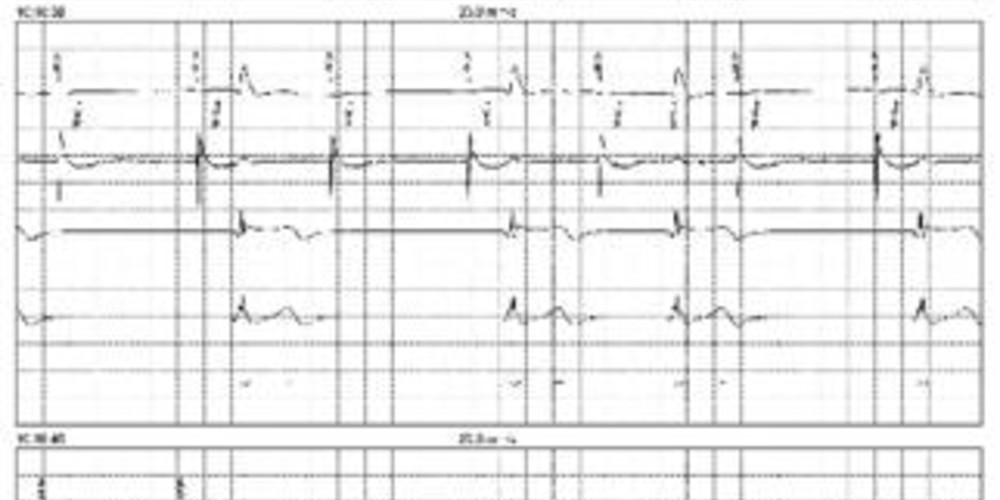Ventricular pacing failure
Tracing
Manufacturer Medtronic
Device PM
Field Pacing & Sensing
N° 13
Patient
65-year-old man implanted with a dual-chamber Ensura pacemaker for syncope due to high grade atrioventricular conduction disorder; severe renal failure; syncope occurring a few hours prior to a dialysis session, 2 months after implantation of the pacemaker.

Graph and trace
The first line corresponds to lead I with the superimposed markers, the second line to the atrial EGM, the third and fourth lines to the ventricular EGM and the last line to lead III;
- proper atrial sensing resulting in an AV delay and ventricular pacing (AS-VP); the ventricular EGMs and the 2 leads show the absence of ventricular capture (no ventricular signal after the stimulus);
- the spontaneous ventricle following the previous P wave is properly detected (VS);
- new atrial sensing sequence - ineffective ventricular pacing (AS-VP); blocked P wave; the base rhythm corresponds to a Wenckebach-type second-degree atrioventricular block (prolongation of the PR interval followed by blocked P wave);
- ineffective ventricular pacing; the ensuing QRS is not detected; this does not correspond to a sensing defect; this QRS falls into the post-ventricular pacing ventricular blanking period, an absolute ventricular refractory period and is therefore not detected;
- continued absence of ventricular capture.
Other articles that may be of interest to you







The pacing threshold corresponds to the smallest electrical pulse, delivered outside of all natural refractory periods, capable of generating the propagation of a depolarization. It can be measured in voltage (Volts) or in pulse width (milliseconds). The determination of the pacing threshold is of major importance since the programming of the voltage and the duration of the pulse defines the safety margin and determines the energy consumption of the prosthesis and therefore the rate of battery wear. It is generally recommended to set a safety margin of 100% which corresponds to a double threshold voltage. This safety margin is designed to take into account the circadian variations in the pacing threshold which is influenced in variable manner from one subject to another by sleep, meals, physical activity, fever, etc. This patient was programmed with a pacing amplitude of 2.5 Volts for 0.4 ms. In dialysis patients, electrolyte conditions (serum sodium, serum calcium, serum potassium, blood glucose) constantly change with possible variations in pacing thresholds, requiring that the pacing outputs be regularly monitored and modified accordingly in order to efficiently capture the myocardium. In this setting, the Capture Management function must be discussed. Indeed, it is now possible to program in all contemporary pacemakers an automatic measurement function of the ventricular threshold more or less associated with an automatic adjustment of the pacing amplitude. For MedtronicTM pacemakers, the Auto-threshold model has been favored, with the ventricular pacing threshold being measured periodically (a single daily measurement) with adjustment of the amplitude as a function of this measurement without cycle to cycle verification of capture efficiency, which requires sufficient safety margins.
In practice, every day at 1 a.m., the pacemaker performs an amplitude measurement of the ventricular pacing threshold for a fixed pulse duration of 0.4 ms. The device evaluates the capture by sensing the signal of the evoked response following each test pacing (differentiation between polarization and evoked response). The search for pacing threshold begins at an amplitude of less than 0.125 V from the last measured threshold. In the absence of a previous search, the search starts at 0.75 V. The device continues to decrease the amplitude in decremental 0.125 V steps until loss of capture. It then increases the amplitude in incremental 0.125 V steps until it regains a capture 3 times in succession (corresponds to the new threshold value). During the threshold measurement procedure, a back-up pacing automatically follows each test pacing (whether captured or not), which prevents the possibility of a ventricular pause during this procedure. The backup pacing is emitted 100 ms after the test pacing; it is performed at the programmed amplitude and at a pulse duration of 1.0 ms. Once the threshold has been measured, the pacing amplitude is automatically adjusted for the next 24 hours without cycle to cycle verification of capture efficiency. The amplitude delivered for these 24 hours is dependent on the programmed values for the « RV amplitude safety margin » and « RV minimum adjusted amplitude » parameters. After a successful pacing threshold search, the device calculates a target amplitude by multiplying the RV amplitude safety margin by the amplitude threshold measured at a pulse duration of 0.4 ms. This adjustment can only be made in an output range defined by a programmable lower limit (Adjusted Minimum Amplitude parameter) and the upper threshold limit of 5.0 V and 1.0 ms. The minimum pulse duration for ventricular threshold control is 0.4 ms.
If the ventricular threshold is measured at 0.4 V for 0.4 ms with a minimum safety margin of twice the threshold and a minimum amplitude of 2 V, the amplitude delivered is 2 V for 0.4 ms. If the ventricular threshold is measured at 1.4 V for 0.4 ms with a minimum safety margin of twice the threshold and a minimum amplitude of 2V, the amplitude delivered is 2.8 V for 0.4 ms. If the ventricular threshold is measured at 3 V for 0.4 ms with a minimum safety margin of twice the threshold and a minimum amplitude of 2V, then the pulse duration is increased. If the new ventricular threshold is measured at 2.5 V for 0.8 ms, the amplitude delivered is 5V for 0.8 ms (amplitude safety margin respected).
In this patient, there were significant variations in the measurement of the threshold throughout the day in conjunction with metabolic disorders. It is likely that the Auto-threshold function is not optimal in this setting, as the evening measurement is not indicative of the measurements made during the day, the cycle to cycle verification not being possible. We have therefore chosen to program a high and fixed pacing amplitude throughout the day.